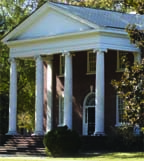Project Profile: A Gate of Opportunity

Berry College, an independent, coeducational college that is ranked among the best colleges of its type in the South, was founded by Martha Berry in 1902 on family land that she added to over the years. It now offers students and visitors from across the country the scenic beauty of fields, forests, lakes, mountains and wildlife preserves - not to mention historic buildings. Known as The Berry Schools in its early years, Berry became a senior college in 1930.
In the early 1920s, Henry Ford, founder of Ford Motor Co., and his wife, Clara, met Martha Berry and built a friendship based on shared interests and ideals. Ford became a generous supporter whose largest gift was funding for a complex of castle-like buildings graced by gargoyle figurines, intricate woodcarvings, stained-glass windows, exquisite Italian stone masonry and traditional slate roofing. The Ford Buildings, coupled with a wide variety of other structures built in the 1920s and 1930s, have helped Berry College become the well-respected jewel it is today.
"Berry College features amazing architecture," says Karilon Rogers, director of public relations and marketing at Berry College. "It is important to preserve the historic integrity of buildings because the college has such a unique history."
Nearly a century later, one of the long-lived historical buildings at Berry College, Evans Hall, home of the Evans School of Humanities and Social Sciences, required renovations.
"Nonstop repairs were occurring on some of the natural slate buildings, so they needed a roofing material that would prevent leaks while maintaining the historic look of the buildings," says Phil Brown, a sales representative at Compton Sales.
The college was hesitant to use just any product to preserve the building's historical appeal. With the inconvenience of non-stop repairs, Berry College's physical plant manager, Mark Hopkins, proposed to use EcoStar Majestic Slate tiles in a federal gray hue on a new residence hall as well as on Evans Hall. The tiles emulate the look and feel of natural slate.
EcoStar's Majestic Slate tiles are 50-year rubber slate tiles that are made of 100 percent recycled industrial rubber and plastic polymers. Injection molded using a special formula that protects the integrity of the rubber, the tiles offer an environmentally friendly, lightweight alternative to slate.
The century-old campus needed an innovative roofing product that would not degrade the campus' ageless aesthetics. "We have received such positive feedback about the tiles," says Hopkins. "In the future, we are going to use EcoStar tiles for other buildings on campus as well."
With nearly 70 percent of its 2,000 students living on-campus and existing on-campus housing filled to capacity, a new residence hall was an essential for Berry College. The new hall, housing 122 students, features 285 squares of Majestic Slate tile. This 58,800-square-foot facility spans a roof of about 21,000 square feet, which features a 6:12 pitch, rises three stories, and offers two-, three- and four-bedroom suites, complete with a kitchen, living room and dining area. Despite seven days of 1/4-inch of rainfall, the installation went smoothly. The residence roof was completed in April 2003, and the entire building construction was finished in July 2003, just in time to welcome students for the fall semester.
"The roof looks like natural slate; you can't tell the difference between the natural slate on the other buildings and the EcoStar tiles," says Tony Watson, project engineer for the Winter Construction Co., Atlanta. And since the product comes with a strong warranty, "We could guarantee that the roof would not fail."
Evans Hall featured an original slate roof covering 15,250 square feet with a 5:12 pitch, which was weakened from the elements, causing the roof deck to become slightly damaged. The roof leaked profusely and posed a threat to the computer systems in the building. Computer equipment was covered and protected to ward off rain damage from the leaking natural slate roof.
The natural slate was removed from the roof and damaged roof deck areas were replaced to ensure proper installation and performance. "The roof was in fair condition but some of the deck was warped, so we removed the tiles, an epoxy resin and finally sections of the deck," says Watson.
The EcoStar tiles weigh 1.26 pounds each, alleviating stress to historic buildings. "The tiles are light and easy-to-handle, but safety is always an issue," says Watson. "The new residence hall featured a steep 6:12 pitch. With school still in session and student traffic at full force, the threat of cracking and breaking tiles was not a concern."
The tile's recycled rubber is molded in the shape of traditional slate, offering easy installation for approved applicators. Shingles can be installed using copper or stainless 1 1/2-inch roofing nails and pneumatic equipment. Breakage is no longer a concern with tiles that can be modified on site with a utility knife. "There was no waste and the EcoStar product was installed three times as fast as natural slate," says John Wesley Banister, contractor and owner of Banister Roofing and Construction Inc.in Rome, Ga.
Berry College's fabled "Gate of Opportunity" is not only for students, faculty and the community; it also was a gate of opportunity for EcoStar to provide a non-traditional roofing alternative for a college with long-lasting traditions.
Looking for a reprint of this article?
From high-res PDFs to custom plaques, order your copy today!


